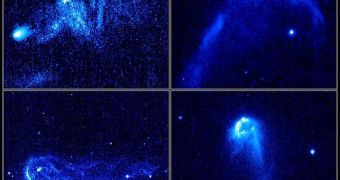According to a new proposal made by researchers at the University in Leiden in the Netherlands, it could be that runaway stars in the Milky Way are the products of failed threesomes within extremely crowded star clusters.
In other words, these objects were common stars at first, moving relatively slowly about their daily lives. However, at this point, more than 20 percent of stars in our galaxy appear to be traveling at speeds in excess of 108,000 kilometers per hour (67,000 miles per hour).
Astronomers first discovered these objects about 50 years ago, and they have been trying to find out how they are produced ever since. A large number of explanations has already been proposed, but this one is particularly interesting due to its implications.
What the team is proposing is that stars become runaways once they meet up with binary systems. The highest likelihood of such an encounter occurring is inside crowded stellar clusters, which can feature tens of thousands of such objects.
If such an encounter occurs, then the single star is captured by the gravitational field of the binary, slung around, and then accelerated to great speeds. The effect is the same as the gravitational slingshot maneuver spacecraft use within the solar system to catch speed on their way to distant destinations.
These conclusions were derived from analyzing a complex computer simulation of how stars would behave on a grand scale inside stellar clusters. Most of the clusters that were emulated in the model had masses between 5,000 and 10,000 times that of the Sun.
When the simulations were run, investigators noted as many as 100 runaway stars being ejected from the cluster, and pulling away at great speed. These results are in tune with data observable near the galactic core, where most runaway stars in the Milky Way are located.
According to UL computational astrophysicist and study coauthor Simon Portegies Zwart, it could be that star clusters actually form at much higher density than currently visible. The difference in density between their beginning and current times may be accounted for by runaway stars.
“One can learn possibly more about the history of a star cluster by looking away from it,” he tells Space, adding that his team will soon start to backtrack the paths of several runaway stars, in order to determine if the computer model was correct.
Details of the new research appear in the November 17 issue of the top journal Science.

 14 DAY TRIAL //
14 DAY TRIAL //